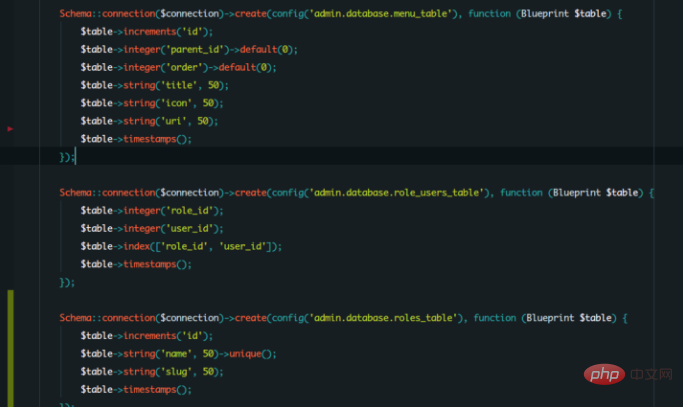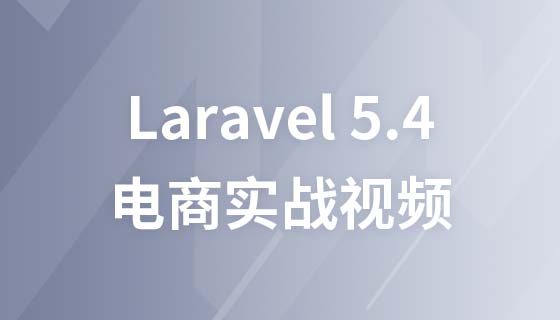以下由Laravel教學專欄為大家介紹Laravel Auth原理淺析,希望對需要的朋友有幫助!

由於公司最近使用Laravel-admin做後台,接觸了下Laravel框架,不得不說,Laravel社區的力量以及生態確實挺強大。
但是公司內部業務都處於Java端,後台全部都是調JavaApi,因此使用Laravel的特性就得大打折扣了,首先Eloquent模型完全不能用,我這邊把業務分開來,只存了3張表,這是Laravel-admin自備的表。

Laravel-admin帶了9張表,由於使用者登入業務全保存在Api端,自備的表功能被我割捨了。因此需要自行實作Api登入的邏輯,而又必須走Laravel Auth認證。
原文理解讀
// 使用下面这个命令Laravel会自动为我们生成Auth路由和认证模块。跟着代码往下解读。 php artisan make:auth // Http/Controllers/Auth/LoginController 使用了 AuthenticatesUsers
其中 下面這三個方法詮釋了登入邏輯的全部。
public function login(Request $request)
{
$this->validateLogin($request);
if ($this->hasTooManyLoginAttempts($request)) {
$this->fireLockoutEvent($request);
return $this->sendLockoutResponse($request);
}
// 这里尝试登录系统,
if ($this->attemptLogin($request)) {
return $this->sendLoginResponse($request);
}
$this->incrementLoginAttempts($request);
return $this->sendFailedLoginResponse($request);
}
protected function attemptLogin(Request $request)
{
return $this->guard()->attempt(
$this->credentials($request), $request->has('remember')
);
}
protected function guard()
{
return Auth::guard();
}控制器會去尋找Auth::guard(), 那這個Auth::guard()是個什麼東西呢,
首先Auth 是系統的單例,原型在
Illuminate\Auth\AuthManager;
顧名思義,是一個Auth管理模組,實作了認證工廠模式介面guards(),
public function __construct($app)
{
$this->app = $app;
$this->userResolver = function ($guard = null) {
return $this->guard($guard)->user();
};
}
// Auth::guard();就是调用了这个方法。
public function guard($name = null)
{
// 首先查找$name, 没有就使用默认的驱动,
$name = $name ?: $this->getDefaultDriver();
// 意思就是要实例化出这个驱动并且返回,
return isset($this->guards[$name])
? $this->guards[$name]
: $this->guards[$name] = $this->resolve($name);
}
// 默认的驱动是从配置文件里面读取的,/config/auth.php default配置项
public function getDefaultDriver()
{
return $this->app['config']['auth.defaults.guard'];
}
// 这里是构造Auth-guard驱动
protected function resolve($name)
{
$config = $this->getConfig($name);
if (is_null($config)) {
throw new InvalidArgumentException("xxx");
}
// 这里是如果你自己实现的驱动就返回
if (isset($this->customCreators[$config['driver']])) {
return $this->callCustomCreator($name, $config);
}
// 这里是系统默认两个类分别是
// session 和 token 这里主要讲 sessionGuard .
$driverMethod = 'create'.ucfirst($config['driver']).'Driver';
if (method_exists($this, $driverMethod)) {
return $this->{$driverMethod}($name, $config);
}
throw new InvalidArgumentException("xxx");
}接下來看看設定檔auth.php
// Auth::guard() ,不传参数,就调用默认的default.guard ,
'defaults' => [
'guard' => 'web',
'passwords' => 'users',
],
// 系统的guard .默认支持 "database", "eloquent",意思就是说你的provider必须是这两个实例中的一个,
'guards' => [
'web' => [
'driver' => 'session',
'provider' => 'users',
],
'api' => [
'driver' => 'token',
'provider' => 'users',
],
],
// 这个就是上面的provider了,你使用哪一个provider作为你的Auth::guard()返回的
// 模型
'providers' => [
'users' => [
'driver' => 'eloquent',
'model' => App\User::class,
],
// 'users' => [
// 'driver' => 'database',
// 'table' => 'users',
// ],
],也就是說也就是說終歸到底,Auth::guard(), 在預設設定裡面是給我反回了一個sessionGuard .
#主要看下面4個方法
namespace Illuminate\Auth;
class SessionGuard{
public function attempt(array $credentials = [], $remember = false)
{
// 这里触发 试图登录事件,此时还没有登录
$this->fireAttemptEvent($credentials, $remember);
$this->lastAttempted =
$user = $this->provider->retrieveByCredentials($credentials);
// 这里会调用hasValidCredentials,其实就是验证用户名和密码的一个过程
if ($this->hasValidCredentials($user, $credentials)) {
// 如果验证通过了,就调用login方法 .
$this->login($user, $remember);
return true;
}
// 否则就触发登录失败事件,返回假
$this->fireFailedEvent($user, $credentials);
return false;
}
// 这里是登录用户的操作,就是说调用这个方法已经是合法用户了,必须是一个
// AuthenticatableContract 的实例 .
public function login(AuthenticatableContract $user,
$remember = false)
{
// 直接更新session,这里就是把session存起来,session的键在该方法的
// getName() 里边,
$this->updateSession($user->getAuthIdentifier());
if ($remember) {
$this->ensureRememberTokenIsSet($user);
$this->queueRecallerCookie($user);
}
// 触发登录事件,已经登录了这个时候,
$this->fireLoginEvent($user, $remember);
// 将user对象保存到sessionGuard , 后续的类访问Auth::user();直接拿到
$this->setUser($user);
}
// 这里就是经常使用到的 Auth::user()了,具体如何返回看AuthManager里面的
// __call
public function user()
{
if ($this->loggedOut) {
return;
}
if (! is_null($this->user)) {
return $this->user;
}
// 这里读取session拿到user的id ,
$id = $this->session->get($this->getName());
$user = null;
// 如果拿到了id ,查找到该user
if (! is_null($id)) {
if ($user = $this->provider->retrieveById($id)) {
$this->fireAuthenticatedEvent($user);
}
}
$recaller = $this->recaller();
if (is_null($user) && ! is_null($recaller)) {
$user = $this->userFromRecaller($recaller);
if ($user) {
$this->updateSession($user->getAuthIdentifier());
$this->fireLoginEvent($user, true);
}
}
return $this->user = $user;
}
// 这里就直接返回用户id了,
public function id()
{
if ($this->loggedOut) {
return;
}
return $this->user()
? $this->user()->getAuthIdentifier()
: $this->session->get($this->getName());
}
}大體上用戶登入的流程就完了,簡單流程就是
//伪代码
$credentials = $request()->only(['username' ,'password']);
if(Auth::guard("session")->attempt($credentials)){
// 登录成功
}else{
// 登录失败
}實現使用者登入之後才能存取的控制器/方法
Route::get("/home")->middleware("auth");
// auth Middleware 是在app/Http/Kernel中注册的,
// 类名是 \Illuminate\Auth\Middleware\Authenticate::class
// 解析过程实质上是这个方法:
public function handle($request, Closure $next, ...$guards)
{
$this->authenticate($guards);
return $next($request);
}
protected function authenticate(array $guards)
{
// 默认情况下会去 Auth中寻找authenticate这个方法
if (empty($guards)) {
return $this->auth->authenticate();
}
// 如果middleware中传了参数,会遍历一遍,不通过就抛出异常
foreach ($guards as $guard) {
if ($this->auth->guard($guard)->check()) {
return $this->auth->shouldUse($guard);
}
}
throw new AuthenticationException('Unauthenticated.', $guards);
}
//sessionGuard 中的authenticate其实也就是调用了一遍user方法。
public function authenticate()
{
if (! is_null($user = $this->user())) {
return $user;
}
throw new AuthenticationException;
}第一次寫文,有錯誤請指出謝謝!
以上是關於Laravel Auth原理淺析的詳細內容。更多資訊請關注PHP中文網其他相關文章!



